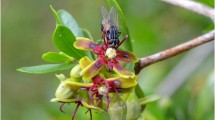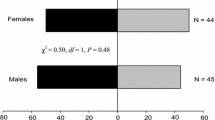Abstract
The responses of walking adult female western flower thrips, Frankliniella occidentalis, to plant volatiles at several concentrations were investigated in a Y-shaped glass tube olfactometer. The simple experimental design allowed comparing the effect of numerous volatiles and differentiated clearly between attractive and repellent compounds. Western flower thrips were attracted by the benzenoids benzaldehyde and pand o-anisaldehyde; the monoterpenes geraniol, nerol, linalool, and (+)-citronellol; the sesquiterpene (E)-β-farnesene, eugenol, and 3-phenylpropionaldehyde; two phenylpropanoids; and the nonfloral odor ethyl nicotinate. p-Anisaldehyde, nerol, ethyl nicotinate, and (E)-β-farnesene elicited positive responses at several concentrations; all other volatiles were attractive at a specific concentration. Salicylaldehyde, a benzenoid, elicited negative responses at two concentrations. Experimental series with several other volatiles belonging to the above mentioned chemical groups and the essential oils from rose and geranium did not result in either clearly positive or negative responses by tested thrips.
Similar content being viewed by others
REFERENCES
Baranowski, T., and Gorski, R. 1993. Chemical attractants in monitoring glasshouse pests. MaterialyXXXIII Sesij Naukowej IOR, Poznan, Poland, pp. 94–97.
Berlinger, M. J., Lebiush-Mordechi, S., Fridja, D., and Mor, N. 1993. The effect of types of greenhouse screens on the presence of western flower thrips: A preliminary study. IOBC /WPRS Bull. 16:13–16.
BrØdsgaard, H. F. 1989. Frankliniella occidentalis (Thysanoptera: Thripidae)—a new pest in Danish glasshouses. A review. Tidsskr. Planteavl 93:83–91.
BrØdsgaard, H. F. 1990. The effect of anisaldehyde as a scent attractant for Frankliniella occidentalis (Thysanoptera: Thripidae) and the response mechanism involved. IOBC /WPRS Bull. 13:36–38.
BrØdsgaard, H. F. 1995. “Keep-down,” a concept of thrips biological control in ornamental pot plants, pp. 221–224, in B. L. Parker, M. Skinner, and T. Lewis (eds.). Thrips Biology and Management: Proceedings of the 1993 International Conference on Thysanoptera. Plenum Press, New York.
Brownbridge, M. 1995. Prospects of mycopathogens in thrips management, pp. 281–295, in B. L. Parker, M. Skinner, and T. Lewis (eds.). Thrips Biology and Management: Proceedings of the 1993 International Conference on Thysanoptera. Plenum Press, New York.
Dethier, V. G., Barton Browne, L., and Smith, C. N. 1960. The designation of chemicals in terms of the responses they elicit from insects. J. Econ. Entomol. 53:134–136.
Frey, J. E., Cortada, R. V., and Helbling, H. 1994. The potential of flower odors for use in population monitoring of western flower thrips. Frankliniella occidentalis Perg. (Thysanoptera: Thripidae). Biocontr. Sci. Technol. 4:177–186.
Gaum, W. G., Giliomee, J. H., and Pringle, K. L. 1994. Resistance of some rose cultivars to the western flower thrips, Franliniella occidentalis (Thysanoptera: Thripidae). Bull. Entomol. Res. 84:487–492.
Gerin, C. 1994. Etude par olfactométrie de l'attractivité de la plante hôte sur Frankliniella occidentalis. Med. Fac. Landbouww. Univ. Gent 59:701–707.
Heinz, K. M., Parrella, M. P., and Newman, J. P. 1992. Time-efficient use of yellow sticky traps in monitoring insect populations. J. Econ. Entomol. 85:2263–2269.
Hollister, B., Cameron, E. A., and Teulon, D. A. J. 1995. Effect of p-anisaldehyde and a yellow color on behavior and capture of western flower thrips, pp. 571–574, in B. L. Parker, M. Skinner, and T. Lewis (eds.). Thrips Biology and Management: Proceedings of the 1993 International Conference on Thysanoptera. Plenum Press, New York.
Holtmann, H. 1963. Untersuchungen zur Biologie der Getreide-Thysanopteren. Teil II. Z. Angew. Entomol. 51:285–299.
Kirk, W. D. J. 1985. Effect of some floral scents on host finding thrips (Insecta: Thysanoptera). J. Chem. Ecol. 11:35–43.
Knudsen, J. T., Tollsten, L., and Bergstrom, L. G. 1993. Floral scents—A checklist of volatile compounds isolated by headspace techniques. Phytochemistry 33:253–280.
Manjunatha, M., Pickett, J. A., Wadhams, L. J., and Nazzi, F. 1998. Response of western flower thrips Frankliniella occidentalis and its predator Amblyseius cucumeris to chrysanthemum volatiles in olfactometer and greenhouse trials. Insect Sci. Appl. 18:139–144.
Mateus, C., and Mexia, A. 1995. Western flower thrips response to color, pp. 567–570, in B. L. Parker, M. Skinner, and T. Lewis (eds.). Thrips Biology and Management: Proceedings of the 1993 International Conference on Thysanoptera. Plenum Press, New York.
Morgan, A. C., and Crumb, S. E. 1928. Notes on the chemotrophic responses of certain insects. J. Econ. Entomol. 21:913–920.
Murai, T. 1990. Rearing method and biology of thrips parasitoid, Ceranisus menes. IOBC /WPRS Bull. 13:142–146.
Parrella, M. P, and Murphy, B. 1996. Western flower thrips: Identification, biology and research on the development of control strategies. IOBC /WPRS Bull. 19:115–118.
Penman, D. R., Osborne, G. O., Worner, S. P., CHAPMAN, R. B., and McLAREN, G. F. 1982. Ethyl nicotinate: A chemical attractant for Thrips obscuratus (Thysanoptera: Thripidae) in stonefruit in New Zealand. J. Chem. Ecol. 8:1299–1302.
Pow, E. M., Bennison, J. A., Birkett, M. A., Luszniak, M. J., Manjunata, M., Pickett, P. A., Segers, I. S., Wadhams, L. J., Wardlow, L. R., and Woodcock, C. M., 1999. Behavioral responses of western flower thrips (Frankliniella occidentalis) to host plant volatiles, pp. 121–128, in G. Vierbergen and I. Tunç (eds.): Proceedings, VI Int. Symp. Thysanoptera, Akdeniz University, Antalya, Turkey, April 27–May 1, 1998. Akdeniz University, Antalya.
Riduavets, J. 1995. Predators of Frankliniella occidentalis (Perg.) and Thrips tabaci Lind: A review. Wageningen Agric. Univ. Pap. 95:46–87.
Roditakis, N. E., and Lykouressis, D. P. 1996. Prospects for the use of volatile chemicals and a new pyrrole in integrated pest management of western flower thrips. Acta Hortic. 431:513–520.
Sabelis, M. W., and Van de Baan, H. E. 1983. Location of distant spider mite colonies by phytoseiid predators: Demonstration of specific kairomones emitted by Tetranychus urticae and Panonychus ulmi. Entomol. Exp. Appl. 33:303–314.
Sachs, L. 1997. Angewandte Statistik: Anwendung statistischer Methoden. Springer Verlag, Berlin.
Shipp, J. L. 1995. Monitoring of western flower thrips on glasshouse and vegetable crops, pp. 547–555, in B. L. Parker, M. Skinner, and T. Lewis (eds.). Thrips Biology and Management: Proceedings of the 1993 International Conference on Thysanoptera. Plenum Press, New York.
Terry, L. I. 1997. Host selection, communication and reproductive behavior, pp. 65–118, in T. Lewis (ed.). Thrips as Crop Pests. CAB International, Oxon, UK.
Teulon, D. A. J., and Ramakers, P. M. J. 1990. A review of attractants for trapping thrips with particular reference to glasshouses. IOBC /WPRS Bull. 13:212–214.
Teulon, D. A. J., Hollister, B., and Cameron, E. A. 1993a. Behavioral responses of western flower thrips to anisaldehyde, and implications for trapping in greenhouses. IOBC /WPRS Bull. 16:177–180.
Teulon, D. A. J., Penman, D. R., and Ramakers, P. M. J. 1993b. Volatile chemicals for thrips (Thysanoptera: Thripidae) host finding and applications for thrips pest management. J. Econ. Entomol. 86:1405–1415.
Vernon, R. S., and Gillespie, D. R. 1990. Spectral responsiveness of Frankliniella occidentalis (Thysanoptera: Thripidae) determined by trap catches in greenhouse. J. Econ. Entomol. 19:1229–1241.
Visser, J. H. 1986. Host odor perception in phytophagous insects. Annu. Rev. Entomol. 31:121–144.
Yamasaki, T., Sato, M., and Sakoguchi, H. 1997. (-)-Germacrene D: Masking substance of attractants for the cerambycid beetle, Monochamus alternatus (Hope). Appl. Entomol. Zool. 32:423–429.
Author information
Authors and Affiliations
Rights and permissions
About this article
Cite this article
Koschier, E.H., De Kogel, W.J. & Visser, J.H. Assessing the Attractiveness of Volatile Plant Compounds to Western Flower Thrips Frankliniella occidentalis. J Chem Ecol 26, 2643–2655 (2000). https://doi.org/10.1023/A:1026470122171
Issue Date:
DOI: https://doi.org/10.1023/A:1026470122171




